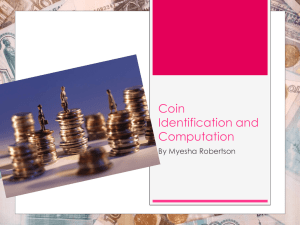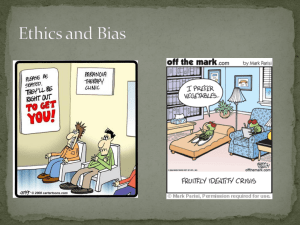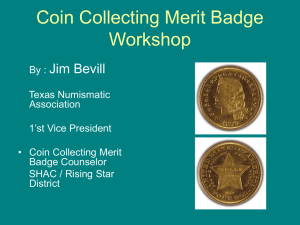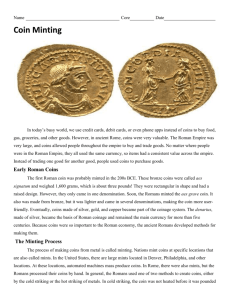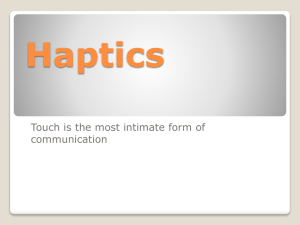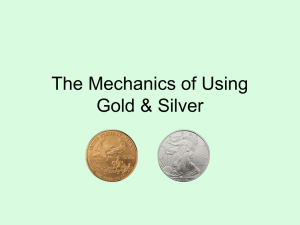Poster
advertisement
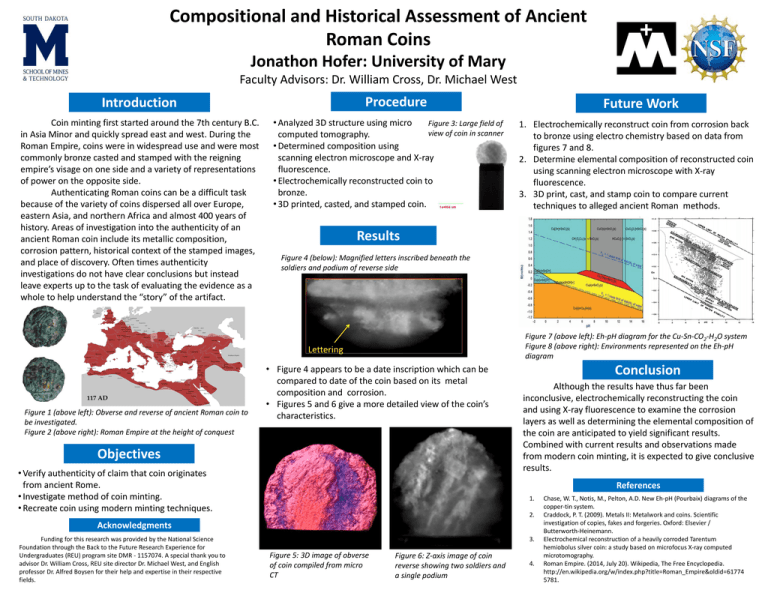
Compositional and Historical Assessment of Ancient Roman Coins Jonathon Hofer: University of Mary Faculty Advisors: Dr. William Cross, Dr. Michael West Procedure Introduction Coin minting first started around the 7th century B.C. in Asia Minor and quickly spread east and west. During the Roman Empire, coins were in widespread use and were most commonly bronze casted and stamped with the reigning empire’s visage on one side and a variety of representations of power on the opposite side. Authenticating Roman coins can be a difficult task because of the variety of coins dispersed all over Europe, eastern Asia, and northern Africa and almost 400 years of history. Areas of investigation into the authenticity of an ancient Roman coin include its metallic composition, corrosion pattern, historical context of the stamped images, and place of discovery. Often times authenticity investigations do not have clear conclusions but instead leave experts up to the task of evaluating the evidence as a whole to help understand the “story” of the artifact. • Analyzed 3D structure using micro Figure 3: Large field of view of coin in scanner computed tomography. • Determined composition using scanning electron microscope and X-ray fluorescence. • Electrochemically reconstructed coin to bronze. • 3D printed, casted, and stamped coin. 1. Electrochemically reconstruct coin from corrosion back to bronze using electro chemistry based on data from figures 7 and 8. 2. Determine elemental composition of reconstructed coin using scanning electron microscope with X-ray fluorescence. 3. 3D print, cast, and stamp coin to compare current techniques to alleged ancient Roman methods. Results Figure 4 (below): Magnified letters inscribed beneath the soldiers and podium of reverse side Figure 7 (above left): Eh-pH diagram for the Cu-Sn-CO2-H2O system Figure 8 (above right): Environments represented on the Eh-pH diagram Lettering Figure 1 (above left): Obverse and reverse of ancient Roman coin to be investigated. Figure 2 (above right): Roman Empire at the height of conquest Future Work • Figure 4 appears to be a date inscription which can be compared to date of the coin based on its metal composition and corrosion. • Figures 5 and 6 give a more detailed view of the coin’s characteristics. Objectives • Verify authenticity of claim that coin originates from ancient Rome. • Investigate method of coin minting. • Recreate coin using modern minting techniques. Conclusion Although the results have thus far been inconclusive, electrochemically reconstructing the coin and using X-ray fluorescence to examine the corrosion layers as well as determining the elemental composition of the coin are anticipated to yield significant results. Combined with current results and observations made from modern coin minting, it is expected to give conclusive results. References 1. 2. Acknowledgments Funding for this research was provided by the National Science Foundation through the Back to the Future Research Experience for Undergraduates (REU) program site DMR - 1157074. A special thank you to advisor Dr. William Cross, REU site director Dr. Michael West, and English professor Dr. Alfred Boysen for their help and expertise in their respective fields. 3. Figure 5: 3D image of obverse of coin compiled from micro CT Figure 6: Z-axis image of coin reverse showing two soldiers and a single podium 4. Chase, W. T., Notis, M., Pelton, A.D. New Eh-pH (Pourbaix) diagrams of the copper-tin system. Craddock, P. T. (2009). Metals II: Metalwork and coins. Scientific investigation of copies, fakes and forgeries. Oxford: Elsevier / Butterworth-Heinemann. Electrochemical reconstruction of a heavily corroded Tarentum hemiobolus silver coin: a study based on microfocus X-ray computed microtomography. Roman Empire. (2014, July 20). Wikipedia, The Free Encyclopedia. http://en.wikipedia.org/w/index.php?title=Roman_Empire&oldid=61774 5781.


